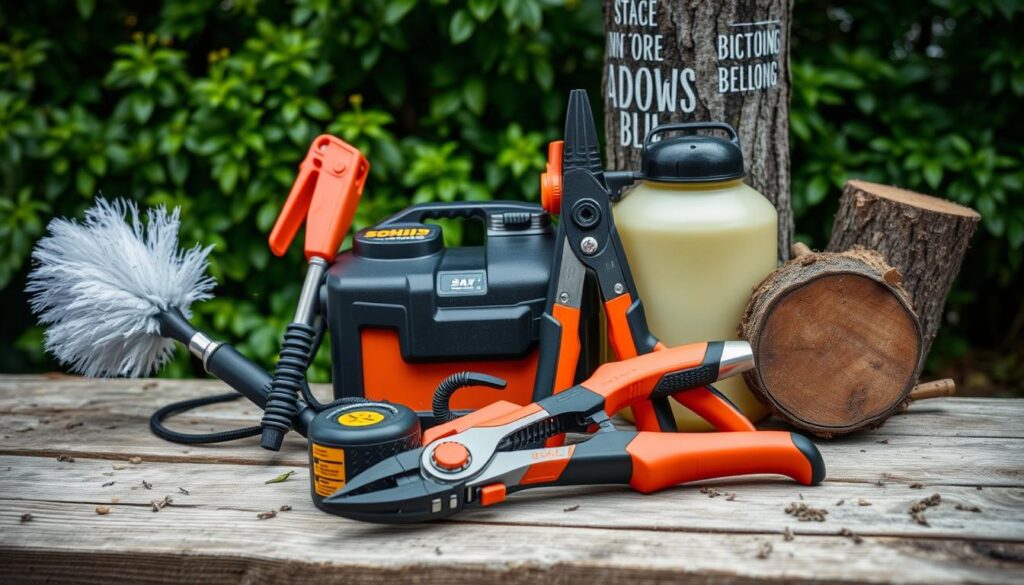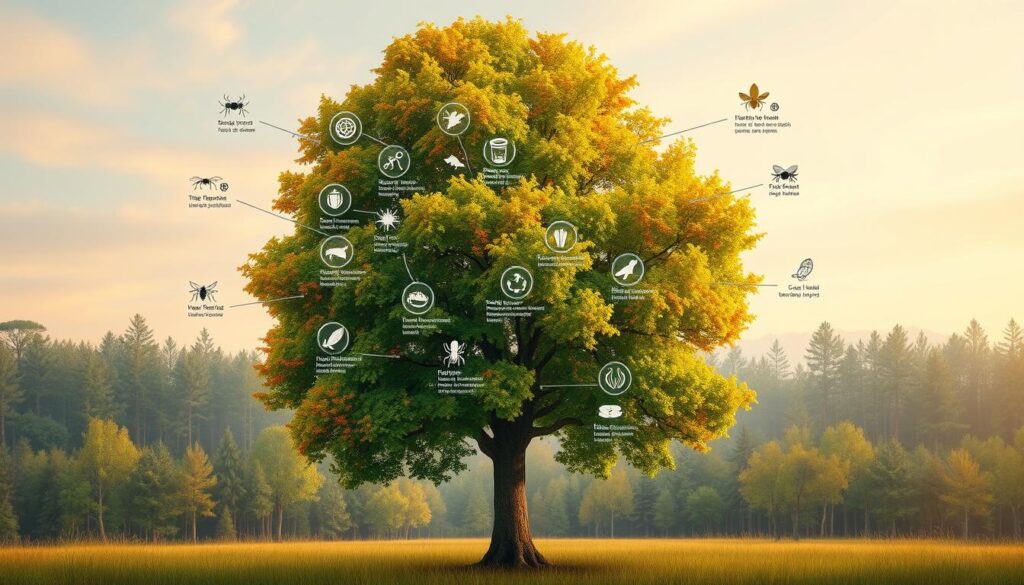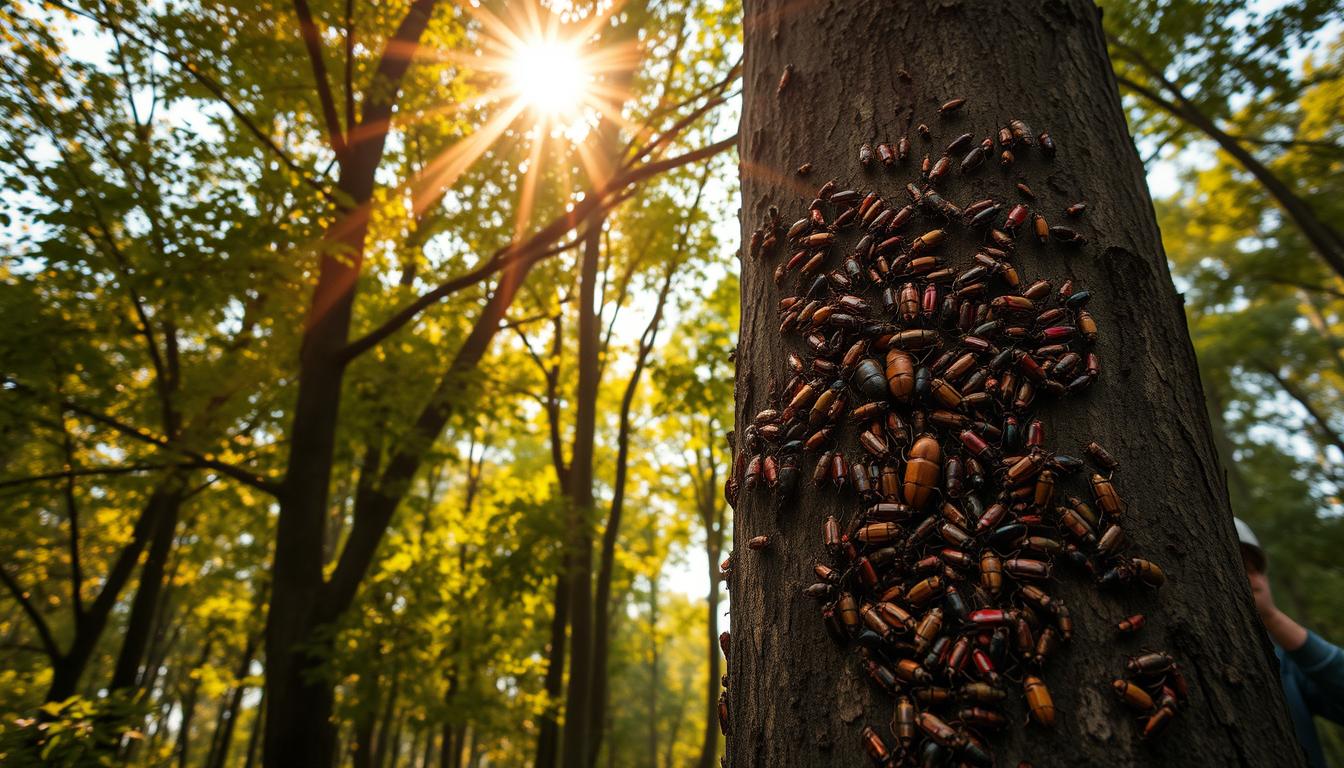The first time I saw tree pests eating my backyard oak, my heart fell. Those small insects were eating my tree, turning it into a potential graveyard. Every gardener knows how tree bugs can quietly destroy trees. Spotting the signs early is key to saving your trees.
Tree bug attacks are serious threats to your landscape’s health and beauty. Whether it’s bark beetles, aphids, or other pests, knowing how to act fast can save your trees. This guide will show you five effective ways to fight tree pests and keep your trees healthy.
By using these strategies, you’ll learn how to protect your trees from harmful insects. This knowledge will help you save your valuable trees from pests.
Table of Contents
Understanding Tree Bug Infestations
Tree bug infestations can quickly harm a healthy landscape. Plant parasites and botanical infestations are big risks to your trees. They can cause lasting damage if not stopped.
It’s key to spot early signs of insect damage to protect your trees. These tiny pests can harm your trees in small but big ways.
Identifying Insect Damage Symptoms
Look out for these important signs of tree insect problems:
- Unexplained wilting or discoloration of leaves
- Small holes in bark or trunk
- Sawdust-like material (frass) around tree base
- Unusual bark peeling or cracking
- Presence of woodborer larvae tracks
Dangerous Tree Insect Varieties
Some tree insects are very harmful:
- Bark beetles
- Emerald ash borers
- Pine bark beetles
- Carpenter ants
- Termites
Potential Tree Health Consequences
Insect infestations can badly harm tree health. Woodborer larvae can damage tree tissues. This can lead to:
- Reduced tree growth
- Weakened structural integrity
- Increased susceptibility to diseases
- Potential tree death
Keeping your trees safe means being watchful, catching problems early, and acting fast against these tiny threats.
Early Detection and Prevention Strategies
Keeping your trees safe from harmful insects starts with watching them closely and taking action early. Bark beetles and leaf miners can harm your trees if not caught in time. Knowing how to spot problems early is key.
It’s important to check your trees often. Do this at least twice a year. Look for signs like:
- Unusual discoloration of leaves
- Small holes in bark or leaves
- Visible insect trails or tunnels
- Wilting or dying branches
Spotting bark beetles early means paying attention. Look for sawdust around trees or tiny holes in bark. Leaf miners create visible trails in leaves, serving as a clear warning sign.
Professional arborists recommend creating a defensive landscape that naturally resists pest invasions.
Here are ways to keep your trees strong:
- Maintain proper tree nutrition
- Ensure adequate watering
- Remove dead or weakened branches
- Apply protective mulch around tree bases
Remember, healthy trees are your best defense against destructive bark beetles and leaf miners. By taking care of your trees, you can lower the risk of damage. This protects your landscape.
Natural Tree Bug Control Solutions
Nature has powerful allies to fight tree pests like sap suckers and gall formers. Sustainable pest management focuses on ecological balance and tree health, not just chemical treatments.
Protecting your trees needs a smart plan that uses nature’s power. By knowing how different life forms interact, you can create a pest control plan. This plan helps reduce damage and keeps your trees healthy.
Beneficial Insects Introduction
Bringing in beneficial insects can change the game for tree pest management. These natural predators control harmful insect populations without using chemicals.
- Ladybugs: Effective against aphids and other small sap suckers
- Lacewings: Consume soft-bodied insects
- Predatory wasps: Target gall formers and leaf-eating insects
Organic Pest Control Methods
Organic solutions are safe and good for the environment. They protect your trees and keep the ecosystem balanced.
- Insecticidal soaps Disrupt insect cell membranes
- Horticultural oils Suffocate insects and their eggs
- Diatomaceous earth: Natural powder that dehydrates insects
Neem Oil Applications
Neem oil is a strong organic pesticide for tree protection. It comes from the neem tree and stops insects from eating and reproducing.
- Dilute neem oil with water before application
- Spray directly on affected tree areas
- Repeat treatment every 7-14 days
Pro tip: Always test neem oil on a small area first to ensure your specific tree species tolerates the treatment.
Professional Treatment Options
When tree bugs infest your trees, DIY methods might not work. Professional arborists have the skills to save your trees from harm. They use advanced methods to treat the problem.
Professional tree bug treatments include several key steps:
- Comprehensive tree health assessments
- Precision trunk injections
- Advanced chemical and organic treatments
- Targeted pest management strategies
Certified arborists use advanced techniques to find and treat tree bugs. Their expertise goes beyond surface-level treatments. They focus on the root cause and protect your trees for the long term.
Professional help is needed when you see:
- Extensive tree canopy damage
- Persistent insect populations
- Signs of structural tree weakness
- Multiple tree species affected
Choosing professional tree bug treatment saves you time and money. It prevents the loss of your trees. Their specialized tools and scientific methods lead to better results than home remedies.
Expert intervention transforms tree bug challenges from potential disasters into manageable solutions.
Essential Tree Care During Infestation
When pests attack your trees, you need a strong care plan. This plan helps your trees recover and stay healthy. It also boosts their natural defenses.
To manage tree pests well, you must support your trees’ healing. Your main tasks are to keep trees healthy, reduce stress, and prevent more pests.
Proper Watering Techniques
Watering stressed trees needs careful attention. Pests can harm roots, so watering is key. Here’s how to do it right:
- Water deeply but infrequently
- Use slow-drip irrigation methods
- Avoid waterlogging soil
- Check soil moisture before watering
Mulching Benefits
Mulching helps fight pests and aids in tree recovery. It offers several benefits:
| Mulching Benefit | Impact on Tree Health |
|---|---|
| Moisture Retention | Reduces water stress |
| Temperature Regulation | Protects root systems |
| Pest Barrier | Limits soil-based insect movement |
Fertilization Requirements
Fertilizing trees helps them fight pests better. Choose balanced, slow-release fertilizers for the best results. They give trees the nutrients they need without harming them.
- Use organic fertilizers
- Apply during active growth periods
- Avoid over-fertilization
- Select nutrient-specific treatments
Tree Bug Management Tools

Keeping your trees safe from pests is crucial. Knowing how to handle woodborer larvae and other pests is vital. It supports your trees’ health and promotes a longer lifespan.
Choosing the right tools for finding and treating pests is the first step. Arborists and homeowners use special gear to fight off insects.
- Pruning shears for removing infected branches
- High-pressure sprayers for targeted insecticide application
- Systemic insecticide injectors for deep tree treatment
- Insect monitoring traps
- Microscopic examination tools
When fighting pests, safety comes first. Always wear gloves, safety glasses, and long-sleeved shirts. This protects you from harmful chemicals.
| Tool Type | Primary Function | Best Used For |
|---|---|---|
| Pruning Shears | Removing infected branches | Localized woodborer larvae damage |
| Pressure Sprayers | Applying liquid treatments | Surface-level insect control |
| Systemic Injectors | Internal tree treatment | Deep-root pest management |
Good tree bug management tools save you time and money. They also help protect your trees. Routine inspections and prompt action can prevent pests from causing serious damage.
Recovery Methods for Damaged Trees
Damage from bark beetles and leaf miners can hurt your landscape a lot. But there are ways to fix your trees and make them strong again. Knowing how to help your trees recover is important for their health and growth.
When pests weaken trees, they need special care to get better. Your plan should focus on healing and supporting the tree’s structure.
Wound Treatment Strategies
Fixing wounds on trees is key after a pest attack. Arborists suggest these steps:
- Clean damaged areas with sterilized pruning tools
- Remove dead or decaying bark carefully
- Apply protective wound dressings
- Minimize additional stress on the tree
Structural Support Options
Some trees need extra help to stay stable. Cabling and bracing can offer the support they need during recovery.
| Support Method | Best Used For | Effectiveness |
|---|---|---|
| Dynamic Cabling | Weak Branch Connections | High |
| Static Bracing | Significant Structural Damage | Medium-High |
| Root Zone Stabilization | Soil Erosion Prevention | Medium |
Growth Stimulation Techniques
Helping trees grow after pest damage needs special care. Try these methods:
- Apply slow-release fertilizers
- Implement deep root watering
- Use mycorrhizal fungal supplements
- Maintain consistent moisture levels
Recovery takes time and careful attention. With the right help and care, your trees can get better and stay healthy. This way, you can stop pests from coming back.
Seasonal Protection Strategies

Protecting your trees from pests like sap suckers and gall formers needs a smart plan. This plan changes with each season. Knowing the challenges each season brings is key to keeping your trees safe.
In winter, get ready to protect your trees from pests. Check the tree bark for signs of pests. Prune dead branches and clean up debris to stop insects from laying eggs.
- Conduct thorough winter tree inspections
- Remove potential insect breeding grounds
- Apply protective tree wraps
Spring brings new pest problems as insects wake up. Look for gall formers on young leaves and branches. These pests can harm your tree by causing abnormal growths and blocking nutrients.
Summer means watching out for sap suckers that love the heat. These pests can take away important nutrients from your tree. Regular checks and treatments can stop serious harm.
“Seasonal awareness is your tree’s best defense against persistent insect threats.” – Urban Forestry Expert
Fall is the time to make your tree strong for winter. Clean up around your tree, remove fallen leaves, and think about pest control to stop pests from coming back.
- Clean tree surroundings
- Remove potential pest habitats
- Apply preventative treatments
By using these seasonal protection tips, you’ll keep your trees safe all year. This way, your trees will stay healthy and strong.
Long-term Prevention Methods
Keeping your trees safe from pests needs a smart plan. A long-term prevention plan protects your trees from harm. It keeps your green spaces healthy and beautiful.
Picking the right tree is key to fighting pests. Some trees are better at fighting off pests. Here are ways to lower the risk of pests:
- Choose native tree species that fit your area well
- Plant trees that naturally fight off pests
- Make your landscape diverse to avoid pest outbreaks
- Keep trees far enough apart for good air flow
Regular checks on your trees are important. Make a plan to check your trees often. Look for signs of pests early on.
Soil health is also crucial. A good soil plan helps trees fight pests. Here’s how to improve your soil:
- Test your soil regularly
- Add organic stuff to boost nutrients
- Keep the soil’s pH just right
- Use special fertilizers
Preventative care and knowing your landscape are key. With these steps, you can keep your trees safe and healthy for a long time.
Conclusion
Protecting your trees from pests needs a careful plan. Knowing the signs of damage and using smart management can help. This way, you can keep your trees safe from harmful insects.
Spotting problems early is key to managing pests. Check your trees often for odd signs and act fast if you see something wrong. Experts say a good plan includes stopping problems before they start, using natural ways to control pests, and using targeted treatments.
Keeping your trees healthy is a big job. Learn to spot dangers, take care of your trees, and use both natural and professional methods. With the right steps, you can make sure your trees grow strong and stay safe from pests.
Tree care is a never-ending job. Keep up with local pest news, take care of your trees, and get help when you need it. Your hard work will pay off, making your outdoor space better for years to come.
FAQ
How can I tell if my tree has a bug infestation?
Watch for indicators such as holes in the bark and abnormal leaf coloration. Also, check for wilting branches and sticky leaves. Sawdust around the tree base is another clue.
Small entry points and bark damage are signs, too. Seeing insects is a clear indicator.
What are the most dangerous tree bugs I should watch out for?
Be cautious of bark beetles, emerald ash borers, and woodborer larvae. Also, watch out for sap-sucking insects and leaf miners. These pests can harm your tree’s structure and even kill it if not treated.
Are there natural ways to control tree bug infestations?
Yes, there are natural ways to fight tree bugs. Introduce beneficial insects like ladybugs. Use neem oil and insecticidal soaps.
Maintain tree health through proper nutrition and attentive care. Horticultural oils and organic pest control can also help manage tree bugs.
When should I call a professional arborist?
Call a professional arborist if you see a lot of damage. Or if you can’t figure out the pest. Also, if your trees are big or valuable.
If DIY methods don’t work, seek professional help. They are essential for severe infestations and complex tree health issues.
How can I prevent future tree bug infestations?
To prevent bugs, care for your trees all year. Regularly inspect them and ensure they get enough water and nutrients. Choose pest-resistant tree species.
Encourage biodiversity in your landscape. Also, address any stress factors that make trees vulnerable to pests.
What seasonal precautions should I take against tree bugs?
Spring is the time to watch for pests. Summer brings heat stress and more insects. Fall is for winter preparation. Winter needs protection against bark damage and hibernating insects.
Keep up with seasonal care to prevent infestations.
Can severely infested trees be saved?
Yes, severely infested trees can be saved with quick action. Early detection and professional help are key. Targeted treatment and comprehensive care can help trees recover.
Success depends on the infestation type, tree health, and treatment timing.
What tools do I need for managing tree bugs?
You’ll need pruning shears, spray applicators, and injectors. Don’t forget protective gear and magnifying glasses. Tree health tools are also important.
For complex infestations, professional equipment might be needed. However, basic tools can help with early detection and management.

